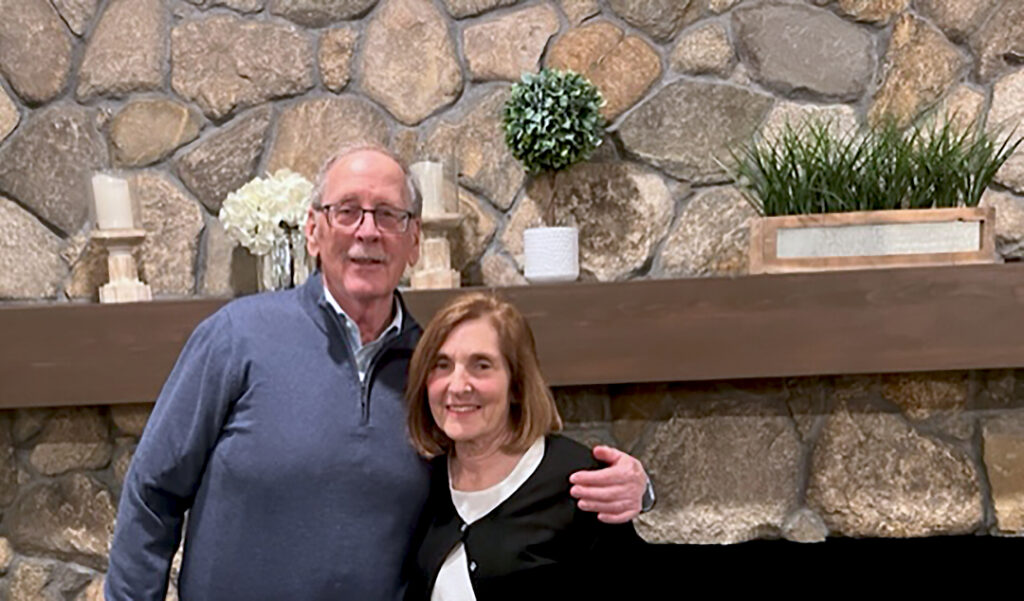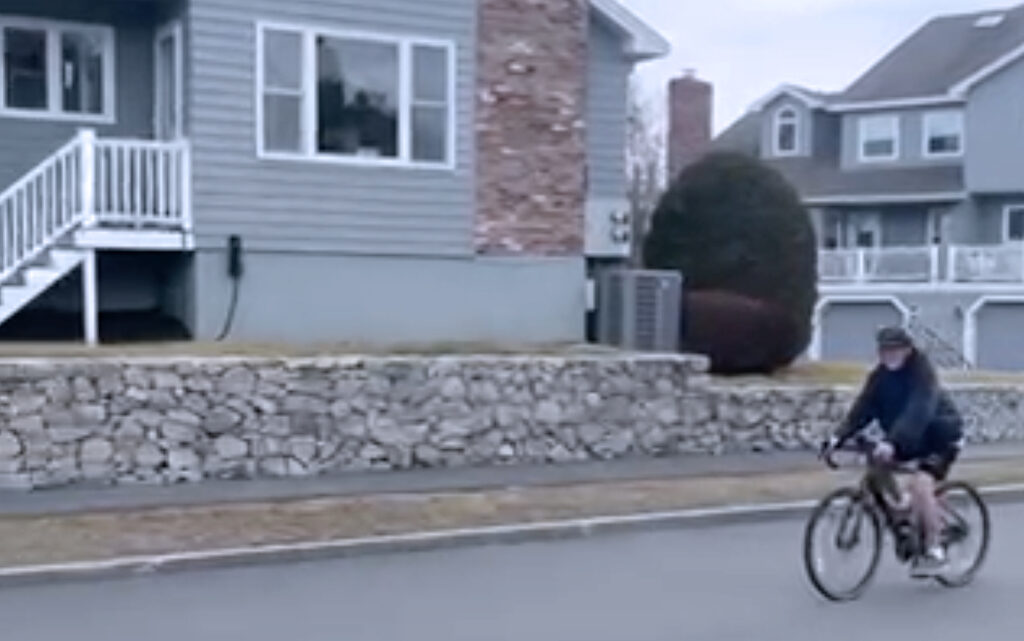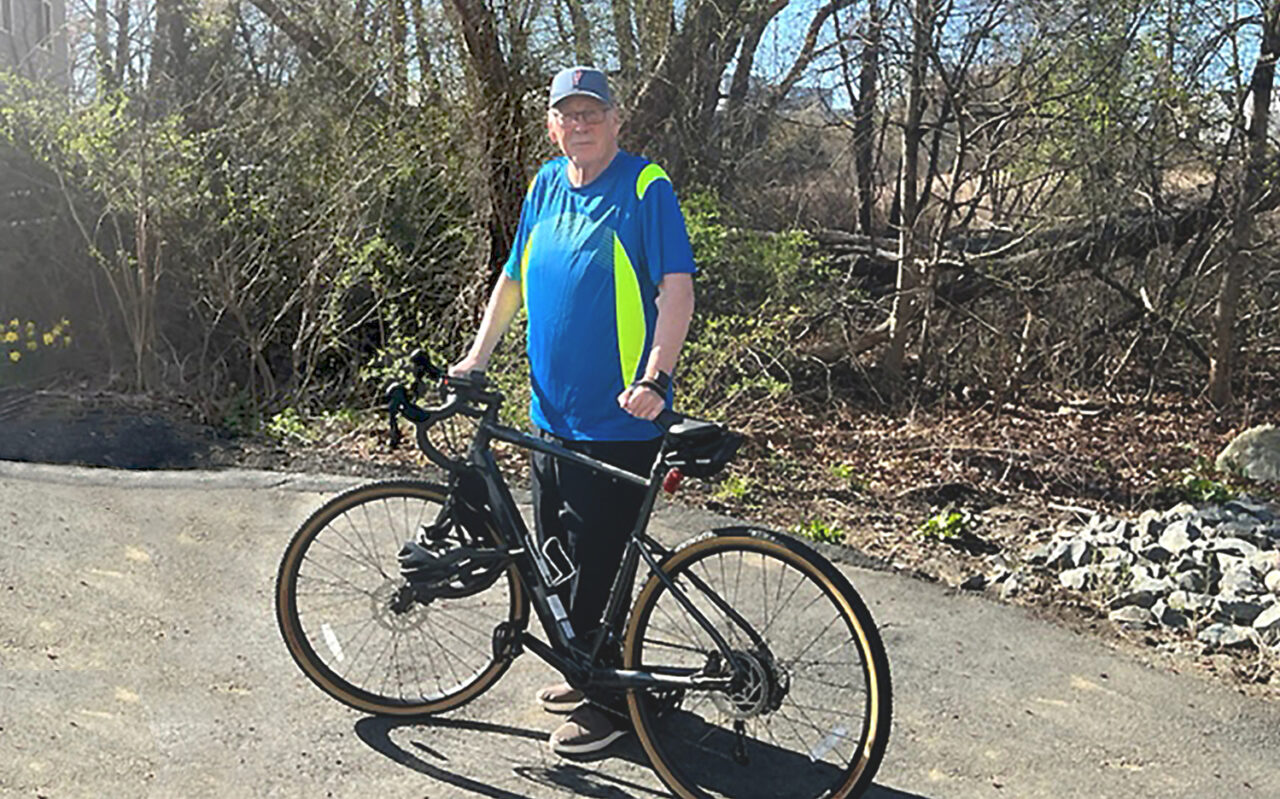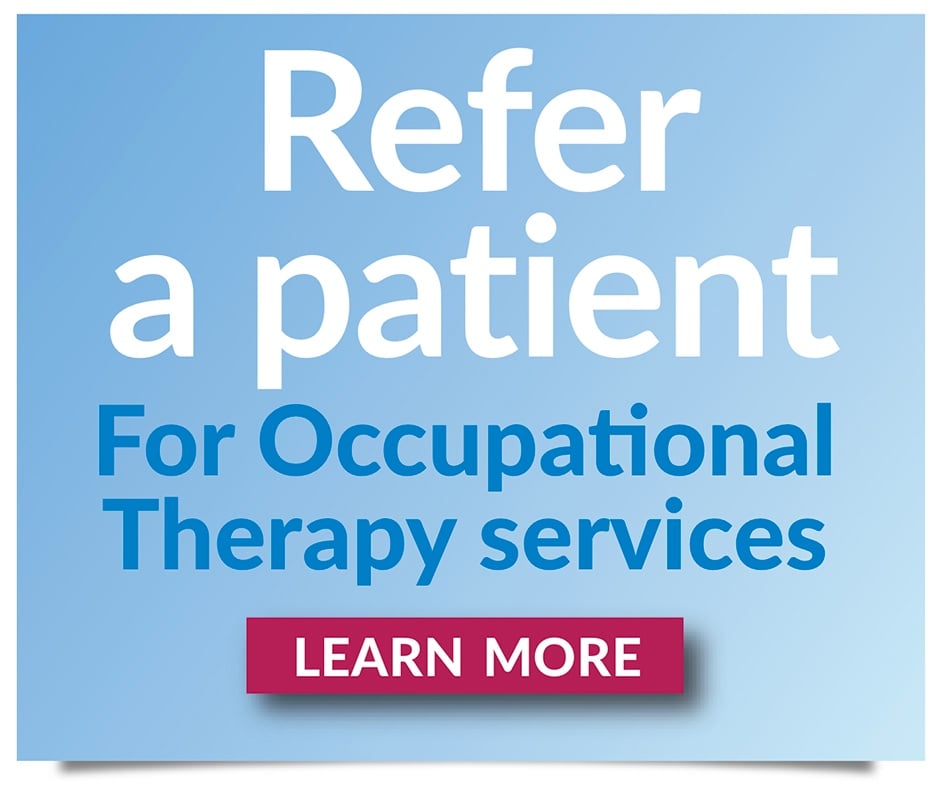“Would like to send Dr. Tollman a video of myself cycling. As a patient last summer/ early fall Dr. Tollman knew my goal was to be able to ride again.”
When we received this email from Gary and Marian Nihan, we knew we had to contact them to learn more about his journey to recovery. Both husband and wife were willing and eager to tell their story about a fall and injury that led them on a yearlong healthcare odyssey that took Gary from acute care to a skilled nursing facility, back home, to the hospital and skilled nursing again, and then ultimately to Whittier Rehabilitation Hospital Bradford, where Dr. Liguori took a chance on him.
In March 2022, while visiting their son’s family in Vermont, Gary tripped and fell, resulting in a bang on the head and a concussion. When Gary got a CAT scan, it appeared to indicate an enlarged ventricle in his brain. The pressure in the ventricle was causing cognitive and physical symptoms, so Gary’s speaking and balance were off.
After Gary returned home, they were trying as a family to piece together the different symptoms they were seeing. The family didn’t know initially that it was NPH (Normal Pressure Hydrocephalus) causing fluid to build up in Gary’s brain. While it is a rare, potentially reversible condition, without appropriate diagnostic testing, NPH is often misdiagnosed as Alzheimer’s disease or other neurodegenerative disorders.
To make matters worse, Gary had another fall in April and broke his hip, leading to hip replacement surgery. Once he recovered from the surgery, he was discharged directly to a rehab facility. Since the NPH remained untreated, Gary’s condition worsened. Marian Nihan said: “At one point, a doctor checking in observed Gary having some drooping and aphasia, and so they kicked right into stroke protocol and sent him right off to the hospital.” While the stroke was later ruled out, another CAT scan showed that some ventricles in his brain were enlarged.
Marian said: “All the while, one of the problems in Gary’s story was that it was very difficult to get him in to be seen by a neurology specialist. We were calling and hoping to get appointments. There was a backlog in being able to see a specialist, and being able to see a specialist would have helped quite a bit. Over this time period, we were waiting and hoping it was going to be NPH because we were told that it was a treatable form of dementia. But we just weren’t getting in to be seen! This went on for another 5 to 6 more weeks beyond the hip surgery.”
As Gary’s condition began to deteriorate more rapidly, the family concluded that his continuing in the acute rehab facility was not a good fit at that time, so they began looking into possibilities for home care.
 Marian continued: “Not knowing what the future could hold, there were a lot of pending decisions to be made about where Gary would be able to stay. I would say that through all of that, Gary, myself, and our three children continued to hope that we would be able to see the neurologist and somehow things would improve.”
Marian continued: “Not knowing what the future could hold, there were a lot of pending decisions to be made about where Gary would be able to stay. I would say that through all of that, Gary, myself, and our three children continued to hope that we would be able to see the neurologist and somehow things would improve.”
“Eventually, after a lot of phone calls, advocating, checking with anyone we knew who had any ties with the hospital and neurology department, we eventually got an appointment for a lumbar puncture,” Marian said. While the initial improvement was instantaneous from the family’s point of view, the effects were short-lived.
Unfortunately, shortly afterward, Gary was hospitalized due to Covid. At this point, four months had gone by since the initial fall and NPH follow-up treatment. Gary was getting worse, and he was sent back to a skilled nursing care center.
However, the family never lost hope. His wife notes that it took a lot of advocating, but eventually they got a neurosurgeon to agree to treat Gary with a shunt, which would drain the fluid from the NPH. They immediately noticed some gradual improvement. “We were told that oftentimes patients who happen to respond well to the shunt are more likely to respond physically, but not necessarily cognitively. So that’s what we were prepared for, but interestingly enough, Gary’s cognitive ability started to come back first: his conversation was so much better right away, even in the recovery room after surgery. We could see that getting the fluid off the brain was definitely helping already.”
“Initially, on paper, Gary did not look like a good candidate for a return to an acute rehab facility. He had an extensive medical history, he had turned 70, and his present condition was pretty low and very dependent. But every time the case manager would come back and say, ‘they’re rejecting him,’ I kept saying, ‘I just can’t accept that.’ He was getting better, albeit slowly. At one point, I was digging in my heels. They were going to discharge him back to the skilled nursing center. I just kept saying ‘he is not going to get the rehab he needs at that center. Nothing like the acute center.’
Marian says: “Finally, the case manager at Tufts Medical gave me some numbers to call. Whittier was on the list.”
Gary recollects: “I think at some point it was more of a personal phone call instead of just looking at the documents on paper, and I think at that point it was Doctor Liguori. Marian told him, ‘he has a doctorate in education; he teaches college-level courses,’ she told him about the physical things I was able to do before, like cycling, etc., Marian thought Whittier was a good facility because it has the three levels of care. Dr. Liguori, from what I understand, read through my history and heard what other people had to say, and said, ‘We’ve got to give this guy a chance.’
So from what I understand, he’s the one who allowed me to get into Whittier. The other facilities just kept reading my past medical history and weren’t willing to negotiate or look at me from a different perspective. Dr. Liguori looked at the medical side, and he also took a humanistic picture of it — that was commendable of him, and that led him to believe that Whittier would be a good place for me.
I got accepted into Whittier in July 2022. Then therapy started, and the nursing care, and all of it was just so good. Kaitlyn was my Occupational Therapist, Joyce was my Physical Therapist, and Kimberly was my Speech Language Pathologist–and all of them were excellent!
The care that I received there was just outstanding. When I arrived there, I was in a wheelchair most of the time, but in a short period of time, everything started to come back.
One of the things they did when I first came in, on the whiteboard in my room, which had peoples’ names, my condition, and so forth, they wrote my two goals on the board: one was to go home and play with my grandchildren, and the other one was to ride my bike again. I knew I would get back to the grandchildren, but I wasn’t sure I would get back to my bike.
I remember Dr. Tollman checking on me, and we struck up a conversation. He said, ‘the grandchildren are great, but you’ll be riding your bike by April.’ I said to myself, ‘I don’t think so!’ because at that point, I was in a wheelchair and didn’t even have use of a cane; I had to hold on to things to walk around the therapy room.
Before long, I was able to do things, the therapists pushed me, and I was much better by the end of August. I was discharged from inpatient and continued with physical therapy at the Whittier Outpatient Center through the fall and winter. Kaitlyn was my OT again, along with OT Lindsey, and Sandy and Angela also pushed me. Jamie was my primary speech therapist, along with Nick. The therapy I received there was outstanding.
 Sandy kept pushing me to achieve my goal to ride my bike, but of course, the weather was sketchy at that point. We had a good President’s Day, and my son said, ‘Let’s try the bike,’ so I got on the bike, and I felt pretty confident, and sure enough, I was able to ride the bike essentially around the block and back and even though I might not have had great balance walking, I just felt really comfortable, and I was in awe of the fact that I could do it. All I could think about was Dr. Tollman saying, ‘You will ride by April,’ and it was still only February! It was just amazing to me that he had the confidence that I was going to improve and that I had the encouragement from all the therapists that I would be able to go back and ride. I felt so good about it, that I went to the Whittier website to see who I could contact in order to let Dr. Tollman see the video of me riding my bike.”
Sandy kept pushing me to achieve my goal to ride my bike, but of course, the weather was sketchy at that point. We had a good President’s Day, and my son said, ‘Let’s try the bike,’ so I got on the bike, and I felt pretty confident, and sure enough, I was able to ride the bike essentially around the block and back and even though I might not have had great balance walking, I just felt really comfortable, and I was in awe of the fact that I could do it. All I could think about was Dr. Tollman saying, ‘You will ride by April,’ and it was still only February! It was just amazing to me that he had the confidence that I was going to improve and that I had the encouragement from all the therapists that I would be able to go back and ride. I felt so good about it, that I went to the Whittier website to see who I could contact in order to let Dr. Tollman see the video of me riding my bike.”
Marian says: “All along, it was a combination of the support and the faith – believing that there would be a better outcome than what we were being told at a lot of junctures, and then, of course, most importantly, was Gary’s willingness to work hard at recovery and his belief that he wouldn’t settle on being in a wheelchair and not being able to ride his bike – that attitude and positivity was huge through all of it. It really did take a village to bring Gary all the way back!”
Gary adds: “The care that I got, and the therapy, now I’m doing things that I couldn’t do before the fall. My right shoulder was very arthritic from years on the job and from throwing the football and baseball numerous times. I was a physical education teacher and a coach and, of course, coached my own kids, too. But now I can do things with my right shoulder that I couldn’t do before. I just can’t say enough. The nurses were just outstanding there! McKenzie, the per diem nurse, was very intelligent. I’ve got to say every nurse was just so positive, so willing to help, and so encouraging. Even Dr. Liguori and Dr. Tollman frequently came to check on me.
Whittier is a great facility and, most importantly, has great staff. I don’t know if I would have gotten to the point where I am now if I had gone to any other facility. If you want good care for rehabilitation, Whittier is the place to go. They have everything you need in terms of equipment – but they also have the willingness to believe in the patient and to listen. The therapists, nurses, doctors, even the people at the desk who handle the scheduling were all great people and very helpful. I can’t say enough good things about Whittier.”
Thank you, Gary and Marian, for telling your story. We do hope that others who read this story will be encouraged by Gary’s recovery, that they will advocate for their loved ones as much as Marian did, and remember that Whittier is there to help on the road to recovery!



